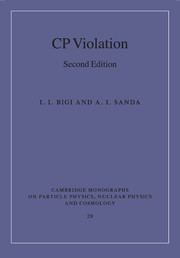Book contents
- Frontmatter
- Contents
- Preface to the second edition
- Preface to the first edition
- Part I Basics of CP violation
- 1 Prologue
- 2 Prelude: C, P and T in classical dynamics
- 3 C, P and T in non-relativistic quantum mechanics
- 4 C, P and T in relativistic quantum theories
- 5 The arrival of strange particles
- 6 Quantum mechanics of neutral particles
- Part II Theory and experiments
- Part III Looking beyond the Standard Model
- Part IV Summary
- References
- Index
5 - The arrival of strange particles
Published online by Cambridge University Press: 10 March 2010
- Frontmatter
- Contents
- Preface to the second edition
- Preface to the first edition
- Part I Basics of CP violation
- 1 Prologue
- 2 Prelude: C, P and T in classical dynamics
- 3 C, P and T in non-relativistic quantum mechanics
- 4 C, P and T in relativistic quantum theories
- 5 The arrival of strange particles
- 6 Quantum mechanics of neutral particles
- Part II Theory and experiments
- Part III Looking beyond the Standard Model
- Part IV Summary
- References
- Index
Summary
The discovery of hadrons with the internal quantum number ‘strangeness’ marks the beginning of a most exciting epoch in particle physics that even now, 50 years later, has not yet reached its conclusion. As we will describe in detail, the discoveries made in this area of research have proved essential in formulating the SM of high energy physics. This is not to say, however, that it has been a particularly glorious chapter for theorists always making successful predictions. On the contrary, we have to admit that by and large experiments have driven the development, and that major discoveries came unexpectedly or even against expectations expressed by theorists. Theorists on the whole have fared better in making postdictions than predictions. Some of the relevant questions remain unanswered today and/or have led to even more profound puzzles.
These discoveries were not spread out evenly over time; some periods were clearly more fertile than others. In this chapter we will give a brief overview of important developments. We do not aim at giving a complete history of this period. Instead we try to give a flavour of the excitement accompanying these discoveries, thus illustrating the thrill and the unexpected turns that can occur in the basic sciences in general and in high energy physics in particular.
The discovery of strange particles
Tracking chambers, being based on ionization, cannot record the passage of a neutral particle. Yet when it decays into two charged particles, the tracks of the decay products can be recorded, and a so-called V pattern arises.
- Type
- Chapter
- Information
- CP Violation , pp. 73 - 89Publisher: Cambridge University PressPrint publication year: 2009



